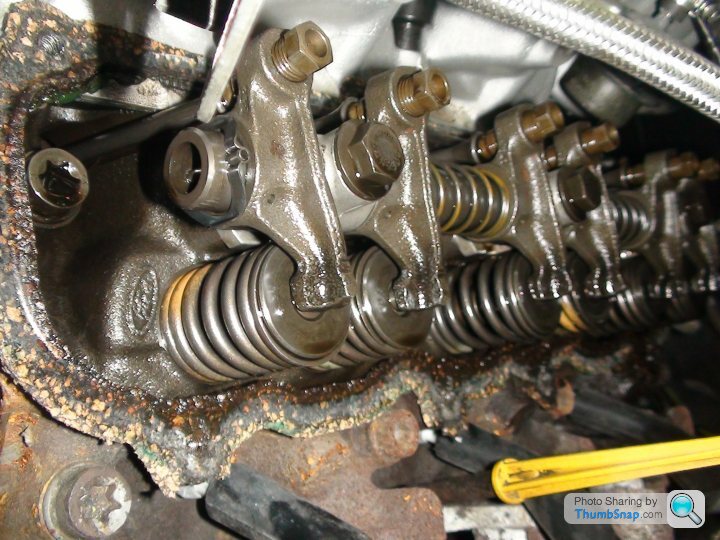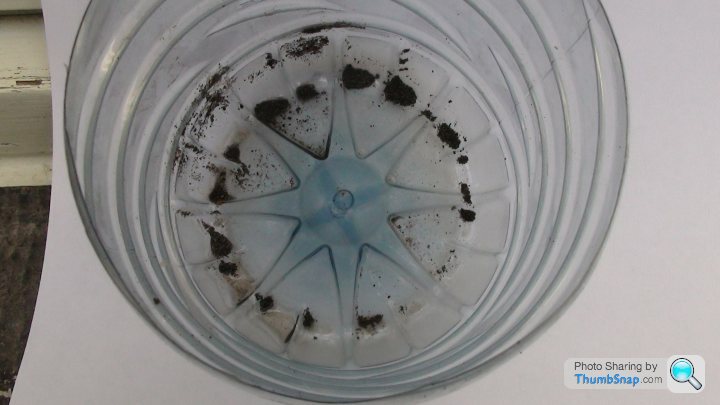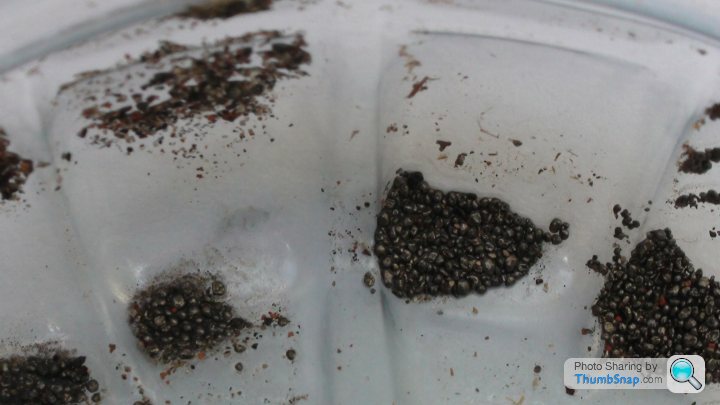Fixed or Hydraulic Tappets?
Discussion
GadgeS3C said:
I was thinking of the feel of adjustment. I agree, no obvious visual differences.
I was going to explain that, but couldn't think how - yes, you can tell if you try to adjust them that it just doesn't feel right, if you've adjusted fixed tappets before - but it's hard to explain what it is, that feels wrong!GadgeS3C said:
I was thinking of the feel of adjustment. I agree, no obvious visual differences.
I was going to explain that, but couldn't think how - yes, you can tell if you try to adjust them that it just doesn't feel right, if you've adjusted fixed tappets before - but it's hard to explain what it is, that feels wrong!From the picture below, could you please tell me if my 1990 S2 is equipped with Fixed or Hydraulic Tappets?

As the engine sounds a bit noisy, I took the rocker cover off and I discovered some dust of steel inside the top of the rocker cover!!! Where could that comme from? Which is the easiest way to adjust tappets (I've never done that job!)
Many thanks for your help.
Best regards,
Geoffrey

As the engine sounds a bit noisy, I took the rocker cover off and I discovered some dust of steel inside the top of the rocker cover!!! Where could that comme from? Which is the easiest way to adjust tappets (I've never done that job!)
Many thanks for your help.
Best regards,
Geoffrey
TopVpowerRoadste said:
From the picture below, could you please tell me if my 1990 S2 is equipped with Fixed or Hydraulic Tappets?
As said above you can't tell by looking ( but 99.5% sure an S2 will be solid)TopVpowerRoadste said:
As the engine sounds a bit noisy, I took the rocker cover off and I discovered some dust of steel inside the top of the rocker cover!!! Where could that comme from?
Now that we could do with a photo of.TopVpowerRoadste said:
Which is the easiest way to adjust tappets (I've never done that job!)
Start by getting yourself a Haynes Manual for a 2.9 Granada then if you're still struggling ask someone local to pop over and show you ( cover my expenses and I'll do it) 
It's not a difficult job but get it wrong (as I recall some one on here did a little while ago) and your engine will not thank you. They should not be more than a few "thou" out if you find yourself turning the nut more than a few degrees the chances are you've gone wrong.
Edited by phillpot on Saturday 25th July 20:44
There are casting letters on the head that denote the type of tappet fitted by Ford. As Ford supplied built engines I'm pretty confident that we can rely upon them.
Not sure if I read it in the 'Bible' or the Haynes manuals (I have both the Sierra and the Granada ones).
Can't double check at the moment as I am 4000 miles away.
Not sure if I read it in the 'Bible' or the Haynes manuals (I have both the Sierra and the Granada ones).
Can't double check at the moment as I am 4000 miles away.
I am pretty sure the casting letters on the head wont help as heads can be interchanged and the hydraulic tappet is in the block rather than the head. The engine number will give a good indication as to whether the engine was built with hydraulic tappets. See the post below. There is an overlap in dates over which the V6 Cologne was made concurrently with or without hydraulic tappets so date alone isnt definitive.
I think I am correct in saying that the two types are interchangeable so a rebuilt later engine might have solid tappets.
http://www.pistonheads.com/gassing/topic.asp?h=0&a...
I think I am correct in saying that the two types are interchangeable so a rebuilt later engine might have solid tappets.
http://www.pistonheads.com/gassing/topic.asp?h=0&a...
greymrj said:
I am pretty sure the casting letters on the head wont help as heads can be interchanged and the hydraulic tappet is in the block rather than the head. The engine number will give a good indication as to whether the engine was built with hydraulic tappets. See the post below. There is an overlap in dates over which the V6 Cologne was made concurrently with or without hydraulic tappets so date alone isnt definitive.
I think I am correct in saying that the two types are interchangeable so a rebuilt later engine might have solid tappets.
http://www.pistonheads.com/gassing/topic.asp?h=0&a...
According to ceelay 73:I think I am correct in saying that the two types are interchangeable so a rebuilt later engine might have solid tappets.
http://www.pistonheads.com/gassing/topic.asp?h=0&a...
another note. The engine number on my car documentation from TVR is just Dxxxx-xxx. ie missing the first two letters but when I looked at the engine itself the BR prefix is there, making mine a BRD engine with hydraulic tappets.
On the engine block of my S2, it is written:
CVGxxx and engine number Dxxxx-xxBR.
Would that mean that my engine has hydraulic tappets?
Thanks for your help.
Best regards,
Geoffrey
I did end the post that that little snippet came from with this:
Quote Me - Disclaimer: I do not know this information to be 100% accurate as it is quoted straight from the autodata referance book and as such do not accept any responsibilty for any damage caused as a result of this information.
The thread also devoloped and got more confusing.
Please do not take any of it as gospel as I still don't truly "know" the answer and do need to find out the truth about mine very soon.
It could all be utter cobblers.
Carl.
hash tag scared it's gonna come back to bite me in the arse!
The kids say something like that don't they?
Quote Me - Disclaimer: I do not know this information to be 100% accurate as it is quoted straight from the autodata referance book and as such do not accept any responsibilty for any damage caused as a result of this information.
The thread also devoloped and got more confusing.
Please do not take any of it as gospel as I still don't truly "know" the answer and do need to find out the truth about mine very soon.
It could all be utter cobblers.
Carl.
hash tag scared it's gonna come back to bite me in the arse!
The kids say something like that don't they?

Start the engine cold until the oil is circulating (a few seconds) then shut it off. Take off rocker cover (or have it already unbolted).
Solid tappets there should be free play in the ones not 'on the cam' hydraulic there won't be any as it will be taken up by oil pressure trapped in the tappet by a one way valve.
Solid tappets there should be free play in the ones not 'on the cam' hydraulic there won't be any as it will be taken up by oil pressure trapped in the tappet by a one way valve.
That doesn't look good!
Was it stuck to the inside of the rocker cover, by oil?
Guess I'd start by taking the rocker shaft off and looking for wear on the rocker arms where they hit the valve stems and/or wear between the arms and the shaft?
Can't see how debris would get washed up into the rocker cover, it's obviously the highest part of the engine so it "must" have originated from that area of the engine?
Oil gets up to there from a small oilway in the head, through one of the rocker pedestals and out along the shaft at each rocker arm.
phillpot said:
That doesn't look good!
I may be wrong Mike but what do you make of the colour of the rocker assembly? That deposit does look like rust and it is very easy to get rust in the top of an engine as a result of condensation if it has been left or is only used for short runs. Doesnt the assembly look a little 'white' and doesnt that look like pitting on the end of the rocker arm. On a good clean well used engine they would be protected by oil and, if anything, look brown. What do you think?I guess a few of us have seen very low mileage engines badly damaged by condensation with loads of rust in the rocker cover?
If it is rust then I would expect to see evidence of condensation damage inside the steel rocker covers, wouldn't you?. The good thing however is that, if this is the case, it doesnt appear to have developed very far and it may well have done no serious damage to the actual moving parts and a good flush with flushing oil may be all that is needed.
Hi everyone,
Thank you for your thoughts and ideas.
In reply to you questions:
The dust of steel was found on the top of the rocker covers, but mainly in the entrance tube where you fill in the engine with oil.
The car has covered over 96.000 miles.
The engine runs fine but is a bit noisy (tappets?).
I bought the car last November from the well know TVR breaker in the North of england and I'm just about to start a full service.
The engine oil is very black and as I have hardly any history of the car, I suspect that it hasn't been well looked after.
A friend of mine suggested that the dust of steel may come from 'bead blasting' (the dust looks like beads), as the rocker cover are chromed ant the outside of the top of the engine seems to have been 'bead or sand blasted'.
Please carry on sending your suggestions/advice/thoughts.
Many thanks,
Geoffrey
Thank you for your thoughts and ideas.
In reply to you questions:
The dust of steel was found on the top of the rocker covers, but mainly in the entrance tube where you fill in the engine with oil.
The car has covered over 96.000 miles.
The engine runs fine but is a bit noisy (tappets?).
I bought the car last November from the well know TVR breaker in the North of england and I'm just about to start a full service.
The engine oil is very black and as I have hardly any history of the car, I suspect that it hasn't been well looked after.
A friend of mine suggested that the dust of steel may come from 'bead blasting' (the dust looks like beads), as the rocker cover are chromed ant the outside of the top of the engine seems to have been 'bead or sand blasted'.
Please carry on sending your suggestions/advice/thoughts.
Many thanks,
Geoffrey
TopVpowerRoadste said:
A friend of mine suggested that the dust of steel may come from 'bead blasting' (the dust looks like beads), as the rocker cover are chromed ant the outside of the top of the engine seems to have been 'bead or sand blasted'.
I'm no expert on bead blasting but looking at the shape of the particles they don't look like a wear product. Much more like blasting beads or similar. Not sure why it's on the inside though

Gassing Station | S Series | Top of Page | What's New | My Stuff





